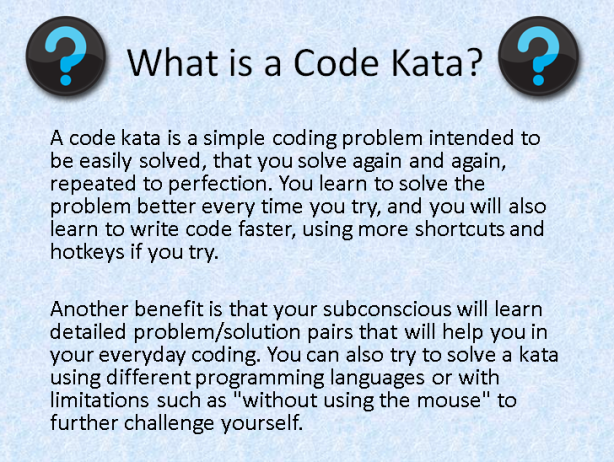One of my teams has recently expressed a desire to become more familiar with XP practices, including more formalised pairing and TDD, and when I offered them the option of doing a code kata during one of our retrospective slots, they were happy to give it a go.
Last year I was fortunate enough to attend a kata at the annual South African Scrum Gathering. The session included some information on what a kata is, some advice on how to run one, plus actually pairing up and practicing. Thankfully the kata used during the Scrum Gathering session was a TDD/Pairing Kata, so I was able to use one that I was familiar with for our first session.
Prep
Preparation entailed
– Sending out some kata context (as not everyone knew what they were)
– Having the team select a development and testing framework and make sure it was all set up
– Finding a suitable room (easier said than done, as it turned out!)
– Sending out some pre-reading about pair programming, particularly the roles and red-green-refactor
From my side, I had to source the kata (thank you, Google) and also enlist the help of some co-facilitators. For this I employed the services of another Scrum Master (who was familiar with katas) and our team architect (who is an advocate of TDD and pairing practices). As you will see from the team’s feedback, having the right coaches/advisors in the room added significant value to the exercise, especially if the majority of your team members are new to the techniques being practiced.
The Session
My session started with an overview of the kata concept and I repeated some key points around TDD and pairing. This probably would not have been necessary if your team is quite good at doing their pre-reading. I did get some feedback that there was too much information and too many instructions up-front, which is probably because both the concept (katas) and the topics (TDD/Pairing) were new ones. In hindsight, some way of splitting the learning probably would have been less confusing. I also printing some of the key TDD/Pairing slides on the back of the kata exercise (although I didn’t notice anyone actually referring back to them during the session). It is important to emphasise that the kata is NOT about how quickly/efficiently you solve the problem, but more about practicing the process to get there. Thankfully, although my team can be quite competitive, I think everyone grasped this.
I decided to run the same kata twice as part of the goal was to actually practice the process itself and one could see the team became a lot more comfortable by the time we ran the second round. We only had an hour, so I opted for 15 minutes per round, which unfortunately meant the round ended just as most teams were hitting ‘flow’. Ideally one would run the kata for half an hour, but in the situation where a team is doing a kata for the first time, I’m not sure whether having one thirty minute Kata is better than two shorter katas to get them familiar. Now that my team have done one, I’d be very comfortable running a single thirty minute session.
The other thing I did was mix up the pairs between sessions. This worked well because people got to see how other teams had approached the same problem plus for more ‘reluctant’ participants (mostly the non-developers), they warmed up by the second round when they realised that most of the team were enjoying the process.
Feedback
I wrapped up the session with a quick 3H (Helped, Hindered, Hypothesis) exercise to get some feedback for myself on how the session went. Overall, I think it went well and it was nice to see the level of interaction and energy it generated. Generally the feedback was good too, so hopefully I’ll have an opportunity to run more of these in the future. In case you’re thinking of running one yourself, here are some of the things the team felt
- Helped them:
– Having an early example (built into our selected kata)
– Coaches for technical and ‘process’ support
– Certain team members having experience with the techniques we were practicing
– Switching partners during the exercise
– Having the developers write the code (based on instructions) even when they weren’t driving
– Pairing with someone who thought differently to you
– Learning in pairs - Hindered them:
– Testing framework (the team could pick what they wanted to use)
– Too little time
– Inexperience with katas
– Initial example was not very clear
– Non developers lacked context
Links
- The TDD/Pairing Kata
- Some more tips
What have you learnt from running katas? Are there any you would particularly recommend?


